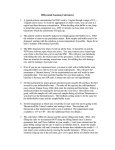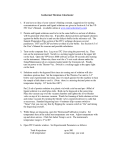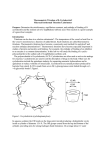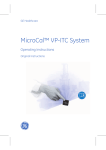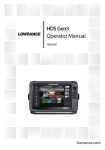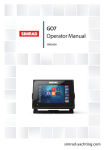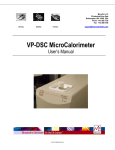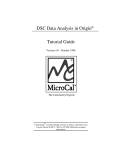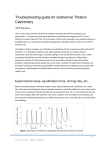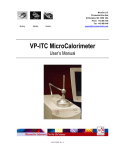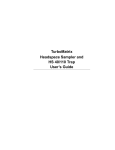Download 2 mg/ml ca - CSBi | Computational and Systems Biology at MIT
Transcript
Differential Scanning Calorimeter 1. A typical protein concentration for DSC work is 1 mg/ml though a range of 0.1— 2 mg/ml can be used. When deciding what buffer to use, keep in mind that some components (e.g., DTT or metals) can have their own heat transitions which the calorimeter will pick up. 2. The DSC functions best when it's left on all the time. It should be on and the VPViewer software open when you arrive. You may want to run a water/water scan if this is the first time you've used the DSC. This will give you familiarity with filling the cells, the trickiest part of the procedure. 3. Even if you are an experienced user, you need to start with a buffer/buffer scan using the dialysis buffer you will use as your reference. This will give the instrument a "thermal history" for the experimental run and will result in more repeatable data. You also need this baseline for your data analysis. 4. ***Before beginning any scans, close the VPViewer software briefly, then reopen it. If we don’t do this, it remembers scans from the previous user.*** 5. Start by degassing enough buffer to fill both the sample and reference cells, about 2 ml. Degas and fill cells at room temperature even if your scans will start at a lower temperature. You should degas buffer (and later, samples) for 10 minutes. 6. You’ll be setting the instrument for many upscans/downscans (maybe 50) and have the first several be your buffer/buffer runs. Once those look good, you’ll refill the sample cell with your real sample during a PreScan Thermostat so you don't lose the thermal history. The feedback setting needs to be the same for the buffer/buffer scans and the sample/buffer scans. 7. The cells hold ~500ul of solution and the narrow filling neck holds ~85ul. Load your solution into the glass filling syringe and be sure to remove air bubbles from it. Insert the needle into the appropriate cell until it touches the bottom then withdraw the needle 1—2 mm. Inject your solution slowly, holding the needle stationary. When you see solution rising up out of the cell stem, give a few gentle bursts of solution from the syringe to dislodge air bubbles from the cell. Also, stir as much as you can with the syringe needle. When you are certain there are no more bubbles in the cell, withdraw the filling syringe. 8. To remove excess solution, use the Filling Adjust Syringe which has a thick collar on its needle. Insert that into the cell as far as it will go then draw back slowly on the plunger to remove excess solution. This will insure that the volume in each cell is correct and will give overlaying baselines. 9. Secure the cap onto the cell port by turning the lower silver portion of the cap as far as it will go. Then turn the top white portion of the cap to increase pressure to ~30 psi, watching the pressure window at the top of the main window. 10. Go to the Setup/Maintenance tab to set your data path. Data is stored in C:\VPDSC\Data. Make a personal folder in there. (You can put data into subfolders in your personal folder but the analysis software won’t be able to find it if you bury it two subfolders down.) 11. On the DSC Controls window, set the total number of scans (upscans and downscans) you want, from 1 to 200. Set the Post Cycle Thermostat to the temperature you want after the last scan has finished. Enter Cell Concentration for later data analysis. (For buffer/buffer scans, that will be zero.) 12. Now set the parameters for your scans. If you don’t need downscan information, make all your scans upscans by choosing Identical Scans. Enter your starting and final temperatures, scan rate (90º/hr is maximum) and a 15 min. PreScan Thermostat. This will be where you have time to add/change samples. A filter period of 10-20 sec. is good for slow (protein) transitions. The correct Feedback Mode for proteins is None. Give your experiment a filename and the software will add a scan number to it for each scan performed. 13. To start your run, click on the Start flag. If you need to change any parameters during the run, go to the DSC Controls window, make the changes, then click on the Update Run Parameters icon on the top toolbar to enter the changes. 14. If you need to stop the run prematurely, click on the Stop icon. Otherwise, the machine will perform all the scans and return to the PostScan Thermostat temperature. 15. To do your data analysis, see the Analyzing DSC Data protocol (on the website) which is a quick reference guide to the Origin Tutorial Guide manual. 16. Remove your sample from the sample cell. If there was no precipitation and you're setting up more scans, rinsing the cells 3X with your buffer should suffice. If you are finished with the DSC, remove your sample and buffer and wash each cell with 250 ml of detergent solution. (5% Liqui-Nox is recommended.) Then rinse each cell with 250 ml water and leave them both filled with water. 17. If your sample precipitated, you will need to clean the cells more extensively. See section 4.5 (page 42) of the User's Manual for various options and/or consult with Debby. If your sample contains lipid, see the special cleaning protocol in Additional Notes. 18. Leave the VPViewer software open and the calorimeter thermostatting at 25º. Unplug the computer from the Internet port. Updated: 7/1/15 Note: This protocol is a practical hands-on guide to using the instrument. Reading this is not a substitute for reading the manufacturer's manual, something we strongly recommend that you do.



